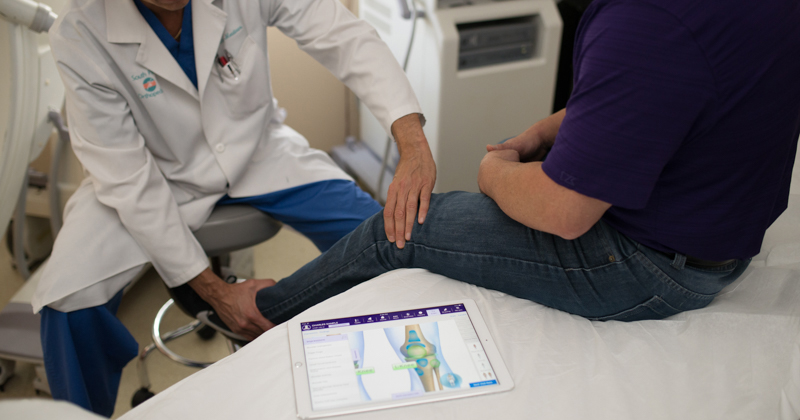Hard Cases: Avoiding the Headaches of Adopting New Orthopedic Technology

This article is part of LinkedIn’s Hard Cases series, where medical professionals share the toughest challenges they’ve faced in their careers. You can read more about it here and follow along using hashtag #HardCases.
Like anyone in the medical field, I’ve spent many hours in the office after dark with a strong cup of coffee and a stack of patient charts and billing codes to complete. You know the deal: bowing out of family events or missing dinner with friends to complete paperwork before the end of the billing cycle.
While many of us fall prey to the assumption that, these days, paperwork comes with a physician’s territory, this shouldn’t be the case. Instead of wrestling with clunky software or wasting valuable time keeping up with ever-changing regulatory updates, technology should help us do what we do best – take care of our patients.
My dual passion for orthopedic surgery and technology has led me to search for a better solution for managing patient records – one that would save me time, not add to my workload. Ultimately, this interest is what led me to work at Modernizing Medicine, where I currently lead the team of physicians and coders who build our orthopedic electronic health record (EHR) system. With my background as a practicing orthopedic physician, I develop the software and processes to actually align with the day-to-day workflows of an orthopedic practice.
While we spend time focused on improving the health of our patients, we can lose sight of the wellbeing of our own practice – leading to inefficiencies. While implementing a new orthopedic practice management and EHR solution can seem like a daunting task, I can attest firsthand that it can ultimately improve workflows, simplify billing and save time.
However, keep these thoughts in mind when you’re considering adopting a new technology solution.
Remember: You’re Not Alone
Whether you’re transitioning from paper charting to an orthopedic EHR system for the first time or switching between systems, it’s important to understand that implementation takes time and planning and that a strong relationship with your EHR vendor is crucial. Find a vendor that offers comprehensive support through the entire implementation process and beyond.
Also critically important is the selection of an orthopedic EHR developed only for our specialty. Many EHR systems are not built by practicing physicians, so they can be hard for us to navigate. The workflows for an orthopedic surgeon are very different than those of a dermatologist or family practitioner. A one-size-fits all solution can result in poor user experience, forcing providers to spend extra time wrestling with the system to accurately document patient visits, increasing administrative tasks and physician burnout. An orthopedic solution that knows your workflow can increase the precious face-to-face time spent with patients, instead of getting in the way.
Getting Everyone on Board
Staff buy-in can be the one of the hardest parts of the process. Many physicians and staff members have been with their practice for years and switching this up can be a hard pill to swallow. Keep the lines of communication open and ask for the input of staff who will work most closely with the new system.
It’s important that staff know early on the benefits that can come from the solution. For me, one of the key benefits has been the way that our EHR cross checks patient medications, which I use to help minimize errors. Knowing at a glance what other medications a patient is taking when prescribing a new drug is crucial, especially with the narcotics crisis.
Simplifying Billing
Keeping up with the latest billing codes can be a full time job of its own. An orthopedic EHR system should help with this burden by suggesting billing codes and providing documentation. Your EHR system should help you with the new regulations and requirements surrounding value-based care and the transition to the Merit-based Incentive Payment System (MIPS).
Integrated Solutions
It makes it a lot easier when your EHR system, your orthopedic practice management system, analytics software and revenue cycle management services are all offered by the same vendor. While interoperability is an important topic in health IT, and great strides are being made, the more companies and systems you have to manage makes efficiency that much more difficult. Plus, when they all work in tandem, you can access more data to help provide insight into the clinical, financial and operational aspects of your practice.
Patient Engagement
Physicians aren’t the only ones who can benefit from a new technology. For example, a patient I was recently consulting on with hip arthritis mentioned how beneficial it was to access the online patient portal, particularly when trying to weed through his medications and prescriptions after surgery. Information on the risks and benefits and the medications we’ve discussed is accessible at all times. Not only do the counseling notes in my orthopedic EHR system increase the ability to communicate salient details, but instead of repeating the explanation multiple times, I can discuss concerns and questions more fully knowing that critical information such as medication administration and dosage is readily available in the patient portal.
Cloud Advantages
The benefits of a cloud solution are many. If a patient calls over the weekend with a question or a request for a prescription refill, having a cloud solution means that I can access the necessary medical records on a smartphone in real-time – potentially saving me a trip into the office on my day off. With seamless access to the system, I feel more connected with my patients and, more importantly, they feel more connected to me.
In Conclusion
As you start this process, know that you should consider many factors. But if you can identify an orthopedic EHR system that includes solutions for every part of your practice, it can help you be successful. If you regularly communicate to your staff and keep all stakeholders involved throughout the process, everyone will be invested in the new technology and its potential to enhance your practice. There is some effort to put in up front, but once the system is tailored to your particular needs and unique way of practicing there is much time to be saved. When you take the time to implement a new technology, you’ll want it to continuously evolve and meet your needs even down the road. It’s important to remember that the only constant with technology is that it’s ever-changing. Just as surgical tools advance, the same goes for software.





